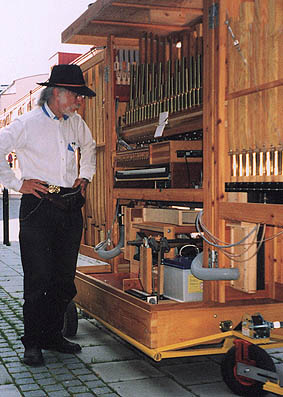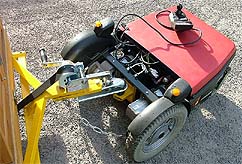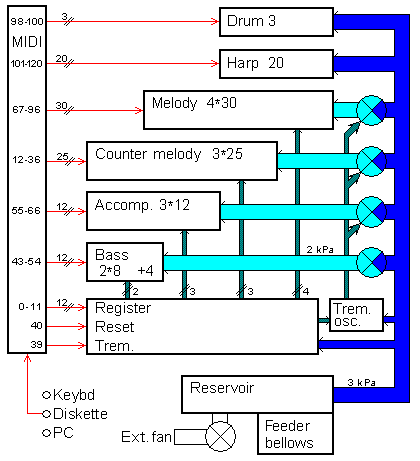

 |
Now it is operable in the street, with bellows powered from a lead battery. Its 350 kg can be winch loaded and moved with a hand trolley on reasonably flat grounds. AB Permobil has sponsored the project with an electric wheelchair chassis that I have modified into a tractor, easing uphill moving significantly. |
| The sound generating part is the four chests of pipes plus a percussive harp and a drum machine. |  |
| Each pipe rank is enabled under control of pneumatic signals from a register unit. This unit is a 15 bit electro-pneumatic memory that can also be manually set up. | |
| Playing is electrically controlled from an Octet MIDI decoder. This provides 128 output lines on its single channel, controlling all note valves throughout, including setting valves on the register unit. The valve magnets are connected via a patchboard which defines the assignment of MIDI codes to notes and controls. | |
| The blowing air is delivered either by feeder bellows located in the bottom frame of the cabinet, or by a remote fan. This air is fed into a reservoir where pressure is regulated to be about 3 kPa (12" water column). After internal distribution, close to each chest, there is an individual regulator to hold chest pressure close to 2 kPa (8" WC), independent of momentary air consumption rate. | |
| The MIDI controls can be taken from any convenient source. For free standing use I use a Viscount RD70-II that plays back files from 3.5" diskettes. |
| Detail description | Background theory. Articles on technical issues of this project in Mechanical Music Digest. |
| Air supply |
'Pushing and bouncing air', about air supply, with focus on transient loads. |
| Electrical
supply |
|
| Wind chests | |
| Regulators |
'Organ pressure regulator and tremulant' design of the pressure regulators and the means to produce a tremulated sound by varying the pressure. |
| Register memory bank | |
| Pipes | 'Recipe
for
Wooden
Organ Flue Pipes', with designers formulæ,
spreadsheet and measurements.
'Pipe
cut-up
and
flue
dimensioning
chart'. The Ising intonation number for the
balancing of dimensions against blowing pressure when
voicing a pipe. |
| Pipe_detuners | |
| Harp | 'Development of an Organ Harp' |
| Drum |
'Drum machine development' |
| MIDI
control |
|
| Tracker |
|
| Music samples |
Pipes |
||||
| Pipe detuners |
Chests | |||
| Register |
|
Tracker |
||
Drum |
||||
| Feeder |